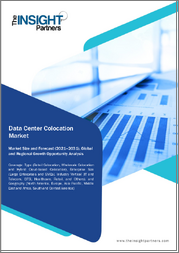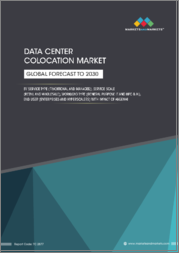
|
시장보고서
상품코드
1690022
데이터센터 코로케이션 시장 규모, 점유율, 성장 분석 : 코로케이션 유형별, Tier 레벨별, 기업 규모별, 최종 사용별, 지역별 - 산업 예측(2025-2032년)Data Center Colocation Market Size, Share, and Growth Analysis, By Colocation Type (Retail Colocation, Wholesale Colocation), By Tier Level (Tier 1, Tier 2), By Enterprise Size, By End Use, By Region - Industry Forecast 2025-2032 |
||||||
데이터센터 코로케이션 시장 규모는 2023년에 696억 달러로, 예측 기간(2025-2032년)의 CAGR은 15.6%로, 2024년 804억 6,000만 달러에서 2032년에는 2,565억 8,000만 달러로 성장할 전망입니다.
2023년 10월 현재, 데이터센터는 주로 비즈니스 용도를 모니터링하기 위해 기업에서 매우 중요한 구성 요소로 부상하고 있습니다. 데이터에 대한 의존도가 높아짐에 따라 강력한 IT 인프라와 클라우드 서비스에 대한 수요가 크게 증가하고 있습니다. 코로케이션 데이터센터는 개별 시설의 건설 및 정비에 따른 높은 비용 없이 진화하는 IT 요구사항에 빠르게 대응할 수 있다는 점에서 점점 더 많은 인기를 얻고 있습니다. 이러한 추세는 클라우드 컴퓨팅, IoT, 로봇 공학 등의 기술 발전과 효율적인 데이터 처리 및 대역폭에 대한 필요성에 힘입어 더욱 가속화되고 있으며, 5G의 등장으로 코로케이션 프로바이더들이 더욱 확대되고, 사용자당에 시설을 전략적으로 배치함으로써 더 빠른 연결과 낮은 비용으로 더 빠른 연결과 낮은 지연을 가능하게 합니다.
목차
서론
- 조사의 목적
- 조사 범위
- 정의
조사 방법
- 정보 조달
- 2차와 1차 데이터 방법
- 시장 규모 예측
- 시장의 전제조건과 제한
개요
- 세계 시장 전망
- 공급과 수요 동향 분석
- 부문별 기회 분석
시장 역학과 전망
- 시장 개요
- 시장 규모
- 시장 역학
- 촉진요인과 기회
- 억제요인과 과제
- Porter의 산업 분석
주요 시장 인사이트
- 주요 성공 요인
- 경쟁의 정도
- 주요 투자 기회
- 시장 에코시스템
- 시장의 매력 지수(2024년)
- PESTEL 분석
- 거시경제 지표
- 밸류체인 분석
- 가격 분석
- 사례 연구
데이터센터 코로케이션 시장 규모 : 코로케이션 유형별 & CAGR(2025-2032)
- 시장 개요
- 소매 코로케이션
- 도매 코로케이션
데이터센터 코로케이션 시장 규모 : Tier 레벨별 & CAGR(2025-2032)
- 시장 개요
- Tier 1
- Tier 2
- Tier 3
- Tier 4
데이터센터 코로케이션 시장 규모 : 기업 규모별 & CAGR(2025-2032)
- 시장 개요
- 대기업
- 중소기업
데이터센터 코로케이션 시장 규모 : 최종 사용별 & CAGR(2025-2032)
- 시장 개요
- 소매
- BFSI
- IT·통신
- 헬스케어
- 미디어·엔터테인먼트
- 기타 최종 사용
데이터센터 코로케이션 시장 규모 : 지역별 & CAGR(2025-2032)
- 북미
- 미국
- 캐나다
- 유럽
- 독일
- 스페인
- 프랑스
- 영국
- 이탈리아
- 기타 유럽 지역
- 아시아태평양
- 중국
- 인도
- 일본
- 한국
- 기타 아시아태평양
- 라틴아메리카
- 브라질
- 기타 라틴아메리카 지역
- 중동 및 아프리카
- GCC 국가
- 남아프리카공화국
- 기타 중동 및 아프리카
경쟁 정보
- 상위 5사의 비교
- 주요 기업의 시장 포지셔닝(2024년)
- 주요 시장 기업이 채택한 전략
- 최근 시장 동향
- 기업의 시장 점유율 분석(2024년)
- 주요 기업의 기업 개요
- 기업의 상세
- 제품 포트폴리오 분석
- 기업의 부문별 점유율 분석
- 매출의 전년대비 비교(2022-2024)
주요 기업 개요
- Equinix, Inc.(US)
- Digital Realty Trust, Inc.(US)
- NTT Communications Corporation(Japan)
- China Telecom Corporation Limited(China)
- Verizon Communications Inc.(US)
- Telehouse(UK)
- China Unicom(China)
- AT&T Inc.(US)
- KDDI Corporation(Japan)
- Deutsche Telekom AG(Germany)
- Colt Technology Services Group Limited(UK)
- Digital Bridge Holdings, LLC(US)
- Corespace, Inc.(US)
- Digital Realty Trust, Inc.(US)
결론과 제안
KSA 25.04.29Data Center Colocation Market size was valued at USD 69.6 billion in 2023 and is poised to grow from USD 80.46 billion in 2024 to USD 256.58 billion by 2032, growing at a CAGR of 15.6% during the forecast period (2025-2032).
As of October 2023, data centers have emerged as crucial components in the corporate landscape, primarily for monitoring business applications. The escalating reliance on data has significantly amplified the demand for robust IT infrastructure and cloud services. Colocation data centers are increasingly popular due to their ability to quickly adapt to evolving IT requirements without the high costs associated with building and maintaining individual facilities. This trend is driven by the need for efficient data processing and bandwidth, spurred by advancements in technology such as cloud computing, IoT, and robotics. The rise of 5G further fuels the expansion of colocation providers, enabling faster connectivity and lower latency by strategically positioning facilities closer to users.
Top-down and bottom-up approaches were used to estimate and validate the size of the Data Center Colocation market and to estimate the size of various other dependent submarkets. The research methodology used to estimate the market size includes the following details: The key players in the market were identified through secondary research, and their market shares in the respective regions were determined through primary and secondary research. This entire procedure includes the study of the annual and financial reports of the top market players and extensive interviews for key insights from industry leaders such as CEOs, VPs, directors, and marketing executives. All percentage shares split, and breakdowns were determined using secondary sources and verified through Primary sources. All possible parameters that affect the markets covered in this research study have been accounted for, viewed in extensive detail, verified through primary research, and analyzed to get the final quantitative and qualitative data.
Data Center Colocation Market Segments Analysis
Global Data Center Colocation Market is segmented by Colocation Type, Tier Level, Enterprise Size, End Use and region. Based on Colocation Type, the market is segmented into Retail Colocation and Wholesale Colocation. Based on Tier Level, the market is segmented into Tier 1, Tier 2, Tier 3 and Tier 4. Based on Enterprise Size, the market is segmented into Large Enterprises and SMEs. Based on End Use, the market is segmented into Retail, BFSI, IT & Telecom, Healthcare, Media & Entertainment and Others. Based on region, the market is segmented into North America, Europe, Asia Pacific, Latin America and Middle East & Africa.
Driver of the Data Center Colocation Market
The burgeoning generation of data from IoT devices, big data analytics, and digital content significantly propels the demand for colocation services. Major companies like Amazon and Google leverage colocation solutions to efficiently manage their extensive data requirements. As the volume of data continues to expand at an unprecedented rate, businesses increasingly turn to colocation as a means to enhance their storage and management capabilities without incurring the high costs associated with building their own infrastructure. This escalating demand driven by the rising data volumes is a key factor advancing the colocation market.
Restraints in the Data Center Colocation Market
One of the primary challenges facing the data center colocation market is the high initial investment required to establish such services. Setting up data colocation involves considerable expenditure on essential infrastructure components like servers, cooling systems, and security protocols. This substantial financial commitment can deter small and medium-sized enterprises from entering the market, effectively restricting their participation and impeding the overall growth of the data colocation sector. As a result, the high upfront costs represent a significant barrier for potential entrants, limiting market expansion and innovation opportunities within the industry.
Market Trends of the Data Center Colocation Market
The Data Center Colocation market is increasingly embracing sustainability as a core trend, driven by organizations' desire to reduce their environmental footprint. The rise of green data centers reflects this shift, with many providers prioritizing energy efficiency and the use of renewable energy sources. Key investments in eco-friendly technologies, such as advanced cooling systems and energy-efficient hardware, are becoming hallmarks of leading colocation firms. This trend not only aligns with corporate social responsibility goals but also meets growing regulatory pressures for sustainability, making eco-friendly data center solutions not just advantageous but essential for maintaining competitive edge in the market.
Table of Contents
Introduction
- Objectives of the Study
- Scope of the Report
- Definitions
Research Methodology
- Information Procurement
- Secondary & Primary Data Methods
- Market Size Estimation
- Market Assumptions & Limitations
Executive Summary
- Global Market Outlook
- Supply & Demand Trend Analysis
- Segmental Opportunity Analysis
Market Dynamics & Outlook
- Market Overview
- Market Size
- Market Dynamics
- Drivers & Opportunities
- Restraints & Challenges
- Porters Analysis
- Competitive rivalry
- Threat of substitute
- Bargaining power of buyers
- Threat of new entrants
- Bargaining power of suppliers
Key Market Insights
- Key Success Factors
- Degree of Competition
- Top Investment Pockets
- Market Ecosystem
- Market Attractiveness Index, 2024
- PESTEL Analysis
- Macro-Economic Indicators
- Value Chain Analysis
- Pricing Analysis
- Case Studies
Global Data Center Colocation Market Size by Colocation Type & CAGR (2025-2032)
- Market Overview
- Retail Colocation
- Wholesale Colocation
Global Data Center Colocation Market Size by Tier Level & CAGR (2025-2032)
- Market Overview
- Tier 1
- Tier 2
- Tier 3
- Tier 4
Global Data Center Colocation Market Size by Enterprise Size & CAGR (2025-2032)
- Market Overview
- Large Enterprises
- SMEs
Global Data Center Colocation Market Size by End Use & CAGR (2025-2032)
- Market Overview
- Retail
- BFSI
- IT & Telecom
- Healthcare
- Media & Entertainment
- Others
Global Data Center Colocation Market Size & CAGR (2025-2032)
- North America (Colocation Type, Tier Level, Enterprise Size, End Use)
- US
- Canada
- Europe (Colocation Type, Tier Level, Enterprise Size, End Use)
- Germany
- Spain
- France
- UK
- Italy
- Rest of Europe
- Asia Pacific (Colocation Type, Tier Level, Enterprise Size, End Use)
- China
- India
- Japan
- South Korea
- Rest of Asia-Pacific
- Latin America (Colocation Type, Tier Level, Enterprise Size, End Use)
- Brazil
- Rest of Latin America
- Middle East & Africa (Colocation Type, Tier Level, Enterprise Size, End Use)
- GCC Countries
- South Africa
- Rest of Middle East & Africa
Competitive Intelligence
- Top 5 Player Comparison
- Market Positioning of Key Players, 2024
- Strategies Adopted by Key Market Players
- Recent Developments in the Market
- Company Market Share Analysis, 2024
- Company Profiles of All Key Players
- Company Details
- Product Portfolio Analysis
- Company's Segmental Share Analysis
- Revenue Y-O-Y Comparison (2022-2024)
Key Company Profiles
- Equinix, Inc. (US)
- Company Overview
- Business Segment Overview
- Financial Updates
- Key Developments
- Digital Realty Trust, Inc. (US)
- Company Overview
- Business Segment Overview
- Financial Updates
- Key Developments
- NTT Communications Corporation (Japan)
- Company Overview
- Business Segment Overview
- Financial Updates
- Key Developments
- China Telecom Corporation Limited (China)
- Company Overview
- Business Segment Overview
- Financial Updates
- Key Developments
- Verizon Communications Inc. (US)
- Company Overview
- Business Segment Overview
- Financial Updates
- Key Developments
- Telehouse (UK)
- Company Overview
- Business Segment Overview
- Financial Updates
- Key Developments
- China Unicom (China)
- Company Overview
- Business Segment Overview
- Financial Updates
- Key Developments
- AT&T Inc. (US)
- Company Overview
- Business Segment Overview
- Financial Updates
- Key Developments
- KDDI Corporation (Japan)
- Company Overview
- Business Segment Overview
- Financial Updates
- Key Developments
- Deutsche Telekom AG (Germany)
- Company Overview
- Business Segment Overview
- Financial Updates
- Key Developments
- Colt Technology Services Group Limited (UK)
- Company Overview
- Business Segment Overview
- Financial Updates
- Key Developments
- Digital Bridge Holdings, LLC (US)
- Company Overview
- Business Segment Overview
- Financial Updates
- Key Developments
- Corespace, Inc. (US)
- Company Overview
- Business Segment Overview
- Financial Updates
- Key Developments
- Digital Realty Trust, Inc. (US)
- Company Overview
- Business Segment Overview
- Financial Updates
- Key Developments



















